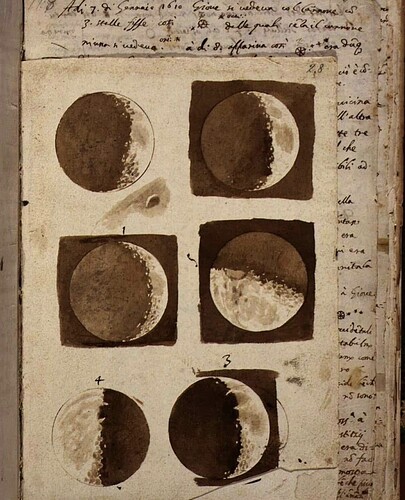These are the first detailed drawings of the moon by Galileo Galilei after he observed them through his homemade telescope in 1609. Here are Galileo’s own words after observing the surface of the moon:
“Let me speak first of the surface of the Moon, which is turned towards us. For the sake of being understood more easily, I distinguish two parts in it, which I call respectively the brighter and the darker. The brighter part seems to surround and pervade the whole hemisphere; but the darker part, like a sort of cloud, discolours the Moon’s surface and makes it appear covered with spots. These spots have never been observed by anyone before me; and from my observations of them, often repeated, I have been led to that opinion which I have expressed, namely, that I feel sure that the surface of the Moon is not perfectly smooth, free from inequalities and exactly spherical, as a large school of philosophers considers with regard to the Moon and the other heavenly bodies, but that, on the contrary, it is full of inequalities, uneven, full of hollows and protuberances, just like the surface of the Earth itself, which is varied everywhere by lofty mountains and deep valleys.”
He goes on to discuss his observations of the Milky Way:
“The next object which I have observed is the essence or substance of the Milky Way. By the aid of a telescope, anyone may behold this in a manner which so distinctly appeals to the senses that all the disputes which have tormented philosophers through so many ages are exploded at once by the irrefragable evidence of our eyes, and we are freed from wordy disputes upon this subject, for the Galaxy is nothing else but a mass of innumerable stars planted together in clusters. Upon whatever part of it you direct the telescope straightway a vast crowd of stars presents itself to view; many of them are tolerably large and extremely bright, but the number of small ones is quite beyond determination.”

